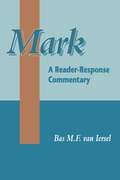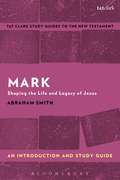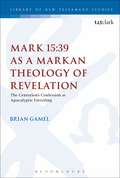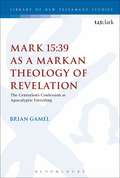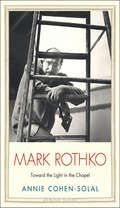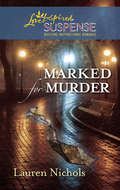- Table View
- List View
Marion and Theology (Philosophy and Theology)
by Prof Christina M. GschwandtnerJean-Luc Marion's early work on Descartes and his more recent writings in phenomenology have not only elicited huge interest in France and the US, but also created huge potential in the field of theology. This book is organised around central questions about the divine raised by Marion's work: how to speak of God, how to approach God, how to experience God, how to receive God, how to believe in God, how to worship God. Within that context it deals with the important aspects of his philosophical work: the inspiration of his writings in what he calls Descartes' "white theology” and its late medieval context as well as the apophatic theology associated with Dionysius the Areopagite; his important claims about idolatrous and iconic ways of speaking of the divine; his notion of the saturated phenomenon or a phenomenology of revelation and givenness, and his extensive writings on love. Christina M. Gschwandtner also considers Marion's explicitly theological writings and establishes their relationship to his larger phenomenological oeuvre. Overall, it approaches Marion's work not only as a philosophy of religion, but with specifically theological questions in mind. It hence shows how Marion's extensive historical and phenomenological work can be profitable and inspiring for theology today, for both systematic questions and for concerns of spirituality, in a way that holds the theoretical and the practical together.
Mark: A Reader-Response Commentary (The Library of New Testament Studies #164)
by Bas M. van IerselThe distinguished Dutch New Testament scholar Bas van Iersel offers us an incisive and comprehensive episode-by-episode commentary on the Gospel of Mark. His special focus is on the contribution of each episode to the overall meaning of the gospel, at both the level of the story and the level of the discourse. As a reader-response commentator, his concern is everywhere with the effect of Mark's story on its readers, engaging both with the situation of the original audience of Mark-Christians of Gentile origin in Rome shortly after the Neronian persecutions-and with that of the present-day reader. Even the introductions are reader-related: on the role of the reader, the original audience and the reader of today, the overall concentric structure of Mark, and the relation of Mark to the Old Testament.
Mark: Shaping the Life and Legacy of Jesus (T&T Clark’s Study Guides to the New Testament)
by Abraham SmithThis Guide reads the Gospel of Mark as a 1st-century CE story about Jesus, for his followers, and against tyranny or the abusive use of power. First, the book shows students how the Gospel uses the form of a traditional laudatory biography (a 'Life') to reshape the memory of the shame-ridden trials and suffering of Jesus. Such a biography portrayed Jesus' descent (as a son of God), his deeds, and his heroic death, dispelling any notion that the teacher Jesus was a charlatan or huckster. Second, Smith demonstrates how the Gospel devotes a great deal of space to Jesus' training of his disciples - as he calls, commissions, and corrects them in preparation for the difficult moments of their journey.Third, Smith highlights the Gospel's special characterizations of Jesus - as a prophetic envoy, a man of authority, and a philosophical hero - contrasting Jesus' use of power with the abusive use of power by Rome's representatives (Herod Antipas and Pilate).
Mark: Shaping the Life and Legacy of Jesus (T&T Clark’s Study Guides to the New Testament)
by Abraham SmithThis Guide reads the Gospel of Mark as a 1st-century CE story about Jesus, for his followers, and against tyranny or the abusive use of power. First, the book shows students how the Gospel uses the form of a traditional laudatory biography (a 'Life') to reshape the memory of the shame-ridden trials and suffering of Jesus. Such a biography portrayed Jesus' descent (as a son of God), his deeds, and his heroic death, dispelling any notion that the teacher Jesus was a charlatan or huckster. Second, Smith demonstrates how the Gospel devotes a great deal of space to Jesus' training of his disciples - as he calls, commissions, and corrects them in preparation for the difficult moments of their journey.Third, Smith highlights the Gospel's special characterizations of Jesus - as a prophetic envoy, a man of authority, and a philosophical hero - contrasting Jesus' use of power with the abusive use of power by Rome's representatives (Herod Antipas and Pilate).
Mark 13 and the Return of the Shepherd: The Narrative Logic of Zechariah in Mark (The Library of New Testament Studies)
by Paul SloanPaul T. Sloan presents a detailed interpretation of Mark's Olivet Discourse in light of the Gospel's many allusions to the book of Zechariah, and argues that previous studies have rightly demonstrated the influence of Zechariah 9–14 on the Passion Narratives. Sloan shows that this influence is not merely confined to Mark's description of Jesus' final week, but also permeates much of his narrative; informing the Gospel's presentation of Jesus' royal identity, his action in the temple, the role of suffering in the bringing of God's kingdom, and the arrangement and interpretation of the Olivet Discourse.Sloan begins with an extensive review of scholarship on the presence of Zechariah in Mark before analyzing the reception of relevant texts from Zechariah in Second Temple literature. He proceeds to a fresh examination of potential allusions to Zechariah throughout Mark, focusing especially on Mark's use of Zechariah 13:7 and 14:5. In addition to influencing significant themes in Mark's Gospel, Sloan argues that Zechariah provides a helpful framework by which to interpret Mark 13, offering a potential solution to a notorious crux interpretum, namely, why Jesus answers a question about the temple with reference to the coming of the son of man.
Mark 13 and the Return of the Shepherd: The Narrative Logic of Zechariah in Mark (The Library of New Testament Studies)
by Paul SloanPaul T. Sloan presents a detailed interpretation of Mark's Olivet Discourse in light of the Gospel's many allusions to the book of Zechariah, and argues that previous studies have rightly demonstrated the influence of Zechariah 9–14 on the Passion Narratives. Sloan shows that this influence is not merely confined to Mark's description of Jesus' final week, but also permeates much of his narrative; informing the Gospel's presentation of Jesus' royal identity, his action in the temple, the role of suffering in the bringing of God's kingdom, and the arrangement and interpretation of the Olivet Discourse.Sloan begins with an extensive review of scholarship on the presence of Zechariah in Mark before analyzing the reception of relevant texts from Zechariah in Second Temple literature. He proceeds to a fresh examination of potential allusions to Zechariah throughout Mark, focusing especially on Mark's use of Zechariah 13:7 and 14:5. In addition to influencing significant themes in Mark's Gospel, Sloan argues that Zechariah provides a helpful framework by which to interpret Mark 13, offering a potential solution to a notorious crux interpretum, namely, why Jesus answers a question about the temple with reference to the coming of the son of man.
Mark 15: The Centurion's Confession as Apocalyptic Unveiling (The Library of New Testament Studies #574)
by Brian K. GamelIn the Gospel of Mark, Jesus' arrest, trial and execution ends with the Roman centurion who oversees the death process proclaiming Jesus as God's son. Gamel explores two key questions in relation to this moment: what does the centurion mean when he says that Jesus is God's son, and why does he say it? The confession is not made on the basis of any signs nor from any indication that he perceives Jesus' death as honourable or exemplary. This apparent lack of motivation itself highlights a key Markan theme: that this insight is revealed by an apocalyptic act of God, signalled by the tearing of the temple veil. Thus the confession, which we can understand to be made sincerely and knowledgeably, is the result of an act of God's revelation alone. Gamel explores the theory of Mark depicting a story in which all human characters exhibit varying levels of blindness to the spiritual realities that govern their lives. By making a thorough examination of Mark's Gospel – while placing primary focus on the centurion, the study is unlimited and presents a serious examination of the whole Gospel – Gamel concludes his argument with the point that, at the foot of the cross, this blindness is decisively confronted by God's apocalyptic act. The offer of sight to the centurion demonstrates the reconciliation of God and humanity which are otherwise in Mark's Gospel repeatedly presented as antagonistic spheres. Finally, the fact that revelation is offered to a Gentile highlights the inclusion of the nations into the promises of Israel.
Mark 15: The Centurion's Confession as Apocalyptic Unveiling (The Library of New Testament Studies)
by Brian K. GamelIn the Gospel of Mark, Jesus' arrest, trial and execution ends with the Roman centurion who oversees the death process proclaiming Jesus as God's son. Gamel explores two key questions in relation to this moment: what does the centurion mean when he says that Jesus is God's son, and why does he say it? The confession is not made on the basis of any signs nor from any indication that he perceives Jesus' death as honourable or exemplary. This apparent lack of motivation itself highlights a key Markan theme: that this insight is revealed by an apocalyptic act of God, signalled by the tearing of the temple veil. Thus the confession, which we can understand to be made sincerely and knowledgeably, is the result of an act of God's revelation alone. Gamel explores the theory of Mark depicting a story in which all human characters exhibit varying levels of blindness to the spiritual realities that govern their lives. By making a thorough examination of Mark's Gospel – while placing primary focus on the centurion, the study is unlimited and presents a serious examination of the whole Gospel – Gamel concludes his argument with the point that, at the foot of the cross, this blindness is decisively confronted by God's apocalyptic act. The offer of sight to the centurion demonstrates the reconciliation of God and humanity which are otherwise in Mark's Gospel repeatedly presented as antagonistic spheres. Finally, the fact that revelation is offered to a Gentile highlights the inclusion of the nations into the promises of Israel.
Mark 8-16 (The Anchor Yale Bible Commentaries)
by Joel MarcusIn the final nine chapters of the Gospel of Mark, Jesus increasingly struggles with his disciples’ incomprehension of his unique concept of suffering messiahship and with the opposition of the religious leaders of his day. The Gospel recounts the events that led to Jesus’ arrest, trial, and crucifixion by the Roman authorities, concluding with an enigmatic ending in which Jesus’ resurrection is announced but not displayed. In this volume New Testament scholar Joel Marcus offers a new translation of Mark 8†“16 as well as extensive commentary and notes. He situates the narrative within the context of first-century Palestine and the larger Greco-Roman world; within the political context of the Jewish revolt against the Romans (66†“73 C.E.); and within the religious context of the early church’s sometimes rancorous engagement with Judaism, pagan religion, and its own internal problems. For religious scholars, pastors, and interested lay people alike, the book provides an accessible and enlightening window on the second of the canonical Gospels.
Mark 8-16: A New Translation With Introduction And Commentary (The Anchor Yale Bible Commentaries)
by Joel MarcusIn the final nine chapters of the Gospel of Mark, Jesus increasingly struggles with his disciples’ incomprehension of his unique concept of suffering messiahship and with the opposition of the religious leaders of his day. The Gospel recounts the events that led to Jesus’ arrest, trial, and crucifixion by the Roman authorities, concluding with an enigmatic ending in which Jesus’ resurrection is announced but not displayed.In this volume New Testament scholar Joel Marcus offers a new translation of Mark 8–16 as well as extensive commentary and notes. He situates the narrative within the context of first-century Palestine and the larger Greco-Roman world; within the political context of the Jewish revolt against the Romans (66–73 C.E.); and within the religious context of the early church’s sometimes rancorous engagement with Judaism, pagan religion, and its own internal problems. For religious scholars, pastors, and interested lay people alike, the book provides an accessible and enlightening window on the second of the canonical Gospels.
Mark, Manuscripts, and Monotheism: Essays in Honor of Larry W. Hurtado (The Library of New Testament Studies #528)
by Dieter Roth Chris KeithMark, Manuscripts, and Monotheism is organized into three parts: Mark's Gospel, Manuscripts and Textual Criticism, and Monotheism and Early Jesus-Devotion. With contributors hailing from several different countries, and including both senior and junior scholars, this volume contains essays penned in honor of Larry W. Hurtado by engaging and focusing upon these three major emphases in his scholarship. The result is not only a fitting tribute to one of the most influential New Testament scholars of present times, but also a welcome survey of current scholarship.
The Mark of Cain: Guilt and Denial in the Post-War Lives of Nazi Perpetrators
by Katharina von KellenbachThe Mark of Cain fleshes out a history of conversations that contributed to Germany's coming to terms with a guilty past. Katharina von Kellenbach draws on letters exchanged between clergy and Nazi perpetrators, written notes of prison chaplains, memoirs, sermons, and prison publications to illuminate the moral and spiritual struggles of perpetrators after World War II. These documents provide intimate insights into the self-reflection and self-perception of perpetrators. As Germany looks back on more than sixty years of passionate debate about political, personal and legal guilt, its ongoing engagement with the legacy of perpetration has transformed German culture and politics. The willingness to forgive and forget displayed by the father in the parable of the Prodigal Son became the paradigm central to Germany's rehabilitation and reintegration of Nazi perpetrators. The problem with Luke's parable in this context is that, unlike the son in the parable, perpetrators did not ask for forgiveness. Most agents of state crimes felt innocent. Von Kellenbach proposes the story of the mark of Cain as a counter narrative. In contrast to the Prodigal Son, who is quickly forgiven and welcomed back into the house of the father, the fratricidal Cain is charged to rebuild his life on the basis of open communication about the past. The story of the Prodigal Son equates forgiveness with forgetting; Cain's story links redemption with remembrance and suggests a strategy of critical engagement with perpetrators.
The Mark of Cain: Guilt and Denial in the Post-War Lives of Nazi Perpetrators
by Katharina von KellenbachThe Mark of Cain fleshes out a history of conversations that contributed to Germany's coming to terms with a guilty past. Katharina von Kellenbach draws on letters exchanged between clergy and Nazi perpetrators, written notes of prison chaplains, memoirs, sermons, and prison publications to illuminate the moral and spiritual struggles of perpetrators after World War II. These documents provide intimate insights into the self-reflection and self-perception of perpetrators. As Germany looks back on more than sixty years of passionate debate about political, personal and legal guilt, its ongoing engagement with the legacy of perpetration has transformed German culture and politics. The willingness to forgive and forget displayed by the father in the parable of the Prodigal Son became the paradigm central to Germany's rehabilitation and reintegration of Nazi perpetrators. The problem with Luke's parable in this context is that, unlike the son in the parable, perpetrators did not ask for forgiveness. Most agents of state crimes felt innocent. Von Kellenbach proposes the story of the mark of Cain as a counter narrative. In contrast to the Prodigal Son, who is quickly forgiven and welcomed back into the house of the father, the fratricidal Cain is charged to rebuild his life on the basis of open communication about the past. The story of the Prodigal Son equates forgiveness with forgetting; Cain's story links redemption with remembrance and suggests a strategy of critical engagement with perpetrators.
The Mark of the Sacred (Cultural Memory in the Present)
by Jean-Pierre DupuyJean-Pierre Dupuy, prophet of what he calls "enlightened doomsaying," has long warned that modern society is on a path to self-destruction. In this book, he pleads for a subversion of this crisis from within, arguing that it is our lopsided view of religion and reason that has set us on this course. In denial of our sacred origins and hubristically convinced of the powers of human reason, we cease to know our own limits: our disenchanted world leaves us defenseless against a headlong rush into the abyss of global warming, nuclear holocaust, and the other catastrophes that loom on our horizon. Reviving the religious anthropology of Max Weber, Emile Durkheim, and Marcel Mauss and in dialogue with the work of René Girard, Dupuy shows that we must remember the world's sacredness in order to keep human violence in check. A metaphysical and theological detective, he tracks the sacred in the very fields where human reason considers itself most free from everything it judges irrational: science, technology, economics, political and strategic thought. In making such claims, The Mark of the Sacred takes on religion bashers, secularists, and fundamentalists at once. Written by one of the deepest and most versatile thinkers of our time, it militates for a world where reason is no longer an enemy of faith.
Mark Rothko: Toward the Light in the Chapel (Jewish Lives)
by Annie Cohen-SolalMark Rothko, one of the greatest painters of the twentieth century, was born in the Jewish Pale of Settlement in 1903. He immigrated to the United States at age ten, taking with him his Talmudic education and his memories of pogroms and persecutions in Russia. His integration into American society began with a series of painful experiences, especially as a student at Yale, where he felt marginalized for his origins and ultimately left the school. The decision to become an artist led him to a new phase in his life. Early in his career, Annie Cohen-Solal writes, “he became a major player in the social struggle of American artists, and his own metamorphosis benefited from the unique transformation of the U.S. art world during this time.” Within a few decades, he had forged his definitive artistic signature, and most critics hailed him as a pioneer. The numerous museum shows that followed in major U.S. and European institutions ensured his celebrity. But this was not enough for Rothko, who continued to innovate. Ever faithful to his habit of confronting the establishment, he devoted the last decade of his life to cultivating his new conception of art as an experience, thanks to the commission of a radical project, the Rothko Chapel in Houston, Texas. Cohen-Solal’s fascinating biography, based on considerable archival research, tells the unlikely story of how a young immigrant from Dvinsk became a crucial transforming agent of the art world—one whose legacy prevails to this day.
Mark Twain: Preacher, Prophet, and Social Philosopher (Spiritual Lives)
by Gary Scott SmithMark Twain's literary works have intrigued and inspired readers from the late 1860s to the present. His varied experiences as a journeyman printer, river boat pilot, prospector, journalist, novelist, humorist, businessman, and world traveller, combined with his incredible imagination and astonishing creativity, enabled him to devise some of American literature's most memorable characters and engaging stories. Twain had a complicated relationship with Christianity. He strove to understand, critique, and sometimes promote various theological ideas and insights. His religious perspective was often inconsistent and even contradictory. While many scholars have overlooked Twain's strong interest in religious matters, others disagree sharply about his religious views—with many labelling him a secularist, an agnostic, or an atheist. In this compelling biography, Gary Scott Smith shows that throughout his life Twain was an entertainer, satirist, novelist, and reformer, but also functioned as a preacher, prophet, and social philosopher. Twain tackled universal themes with penetrating insight and wit including the character of God, human nature, sin, providence, corruption, greed, hypocrisy, poverty, racism, and imperialism. Moreover, his life provides a window into the principal trends and developments in American religion from 1865 to 1910.
Mark Twain: Preacher, Prophet, and Social Philosopher (Spiritual Lives)
by Gary Scott SmithMark Twain's literary works have intrigued and inspired readers from the late 1860s to the present. His varied experiences as a journeyman printer, river boat pilot, prospector, journalist, novelist, humorist, businessman, and world traveller, combined with his incredible imagination and astonishing creativity, enabled him to devise some of American literature's most memorable characters and engaging stories. Twain had a complicated relationship with Christianity. He strove to understand, critique, and sometimes promote various theological ideas and insights. His religious perspective was often inconsistent and even contradictory. While many scholars have overlooked Twain's strong interest in religious matters, others disagree sharply about his religious views—with many labelling him a secularist, an agnostic, or an atheist. In this compelling biography, Gary Scott Smith shows that throughout his life Twain was an entertainer, satirist, novelist, and reformer, but also functioned as a preacher, prophet, and social philosopher. Twain tackled universal themes with penetrating insight and wit including the character of God, human nature, sin, providence, corruption, greed, hypocrisy, poverty, racism, and imperialism. Moreover, his life provides a window into the principal trends and developments in American religion from 1865 to 1910.
Markan Typology: Miracle, Scripture and Christology in Mark 4:35–6:45 (The Library of New Testament Studies)
by Jonathan Rivett RobinsonResponding to the belief that typology was a later development of the early church, and not applicable to the earliest canonical Gospel, Jonathan Robinson stresses that typology has deep Jewish roots, and that typological modes of thought were a significant part of the Gospel's historical and cultural background. He brings this insight to bear on four of the most dramatic miracles in Mark's Gospel, discovering a surprisingly consistent typological approach. Essential to Robinson's argument is the discovery of distinctive words and phrases taken from the Septuagint, that serve as unique indictors of Mark's intent to refer back to miracles from the Jewish scriptures, pointing to influence from Jonah, David, Elisha and Moses. These references in turn provide insight into Mark's Christology, revealing that Mark presents Jesus as both the fulfilment of scriptural human types and as assuming the narrative form of Israel's God. Robinson argues that rather than imposing categories extracted from earlier Jewish literature like “divine identity” and “exalted human figures”, Mark should be allowed to speak on its own terms and with its own unique voice.
Markan Typology: Miracle, Scripture and Christology in Mark 4:35–6:45 (The Library of New Testament Studies)
by Jonathan Rivett RobinsonResponding to the belief that typology was a later development of the early church, and not applicable to the earliest canonical Gospel, Jonathan Robinson stresses that typology has deep Jewish roots, and that typological modes of thought were a significant part of the Gospel's historical and cultural background. He brings this insight to bear on four of the most dramatic miracles in Mark's Gospel, discovering a surprisingly consistent typological approach. Essential to Robinson's argument is the discovery of distinctive words and phrases taken from the Septuagint, that serve as unique indictors of Mark's intent to refer back to miracles from the Jewish scriptures, pointing to influence from Jonah, David, Elisha and Moses. These references in turn provide insight into Mark's Christology, revealing that Mark presents Jesus as both the fulfilment of scriptural human types and as assuming the narrative form of Israel's God. Robinson argues that rather than imposing categories extracted from earlier Jewish literature like “divine identity” and “exalted human figures”, Mark should be allowed to speak on its own terms and with its own unique voice.
Marked for Murder (Mills And Boon Love Inspired Ser.)
by Lauren NicholsThe Gold Star serial killer is back…
Marked For Revenge (Emergency Responders #2)
by Valerie HansenHe had a price on his head—and no one to trust An Emergency Responders thriller
Marked in Your Flesh: Circumcision from Ancient Judea to Modern America
by Leonard B. GlickThe book of Genesis tells us that God made a covenant with Abraham, promising him a glorious posterity on the condition that he and all his male descendents must be circumcised. For thousands of years thereafter, the distinctive practice of circumcision served to set the Jews apart from their neighbors. The apostle Paul rejected it as a worthless practice, emblematic of Judaism's fixation on physical matters. Christian theologians followed his lead, arguing that whereas Christians sought spiritual fulfillment, Jews remained mired in such pointless concerns as diet and circumcision. As time went on, Europeans developed folklore about malicious Jews who performed sacrificial murders of Christian children and delighted in genital mutilation. But Jews held unwaveringly to the belief that being a Jewish male meant being physically circumcised and to this day even most non-observant Jews continue to follow this practice. In this book, Leonard B. Glick offers a history of Jewish and Christian beliefs about circumcision from its ancient origins to the current controversy. By the turn of the century, more and more physicians in America and England--but not, interestingly, in continental Europe--were performing the procedure routinely. Glick shows that Jewish American physicians were and continue to be especially vocal and influential champions of the practice which, he notes, serves to erase the visible difference between Jewish and gentile males. Informed medical opinion is now unanimous that circumcision confers no benefit and the practice has declined. In Jewish circles it is virtually taboo to question circumcision, but Glick does not flinch from asking whether this procedure should continue to be the defining feature of modern Jewish identity.
Marked in Your Flesh: Circumcision from Ancient Judea to Modern America
by Leonard B. GlickThe book of Genesis tells us that God made a covenant with Abraham, promising him a glorious posterity on the condition that he and all his male descendents must be circumcised. For thousands of years thereafter, the distinctive practice of circumcision served to set the Jews apart from their neighbors. The apostle Paul rejected it as a worthless practice, emblematic of Judaism's fixation on physical matters. Christian theologians followed his lead, arguing that whereas Christians sought spiritual fulfillment, Jews remained mired in such pointless concerns as diet and circumcision. As time went on, Europeans developed folklore about malicious Jews who performed sacrificial murders of Christian children and delighted in genital mutilation. But Jews held unwaveringly to the belief that being a Jewish male meant being physically circumcised and to this day even most non-observant Jews continue to follow this practice. In this book, Leonard B. Glick offers a history of Jewish and Christian beliefs about circumcision from its ancient origins to the current controversy. By the turn of the century, more and more physicians in America and England--but not, interestingly, in continental Europe--were performing the procedure routinely. Glick shows that Jewish American physicians were and continue to be especially vocal and influential champions of the practice which, he notes, serves to erase the visible difference between Jewish and gentile males. Informed medical opinion is now unanimous that circumcision confers no benefit and the practice has declined. In Jewish circles it is virtually taboo to question circumcision, but Glick does not flinch from asking whether this procedure should continue to be the defining feature of modern Jewish identity.
The Market as God
by Harvey CoxThe Market has deified itself, according to Harvey Cox’s brilliant exegesis. And all of the world’s problems—widening inequality, a rapidly warming planet, the injustices of global poverty—are consequently harder to solve. Only by tracing how the Market reached its divine status can we hope to restore it to its proper place as servant of humanity.
Market, Ethics and Religion: The Market and its Limitations (Ethical Economy #62)
by Niels KærgårdThis book deals with the basic question of what money can and cannot buy and offers an analysis of the limitations of the market mechanism. Few concepts are as controversial as religion and the market mechanism. Some consider religion to be in conflict with a modern rational scientific view of life, and thus as a contributory cause of harsh conflicts and a barrier to human happiness. Others consider religious beliefs as the foundation for ethics and decent behaviour. Similar, a number of neoliberal writers acclaimed the market mechanism as one of the greatest triumphs of the human mind, and saw it as the main reason why rich countries became rich. Others are extremely skeptical and stress how this mechanism has result in big multinational firms with powerfully rich owners and masses of poor low-paid workers. Researchers from various fields - economists, social scientists, theologians and philosophers - handle these questions very differently, applying different methods and different ideals. This book offers a synthesis of the different viewpoints. It deals with economists’, theologians’ and philosophers’ differing thoughts about the market and its limitations.

